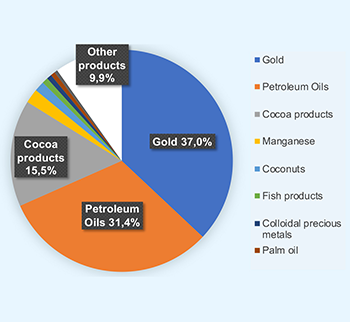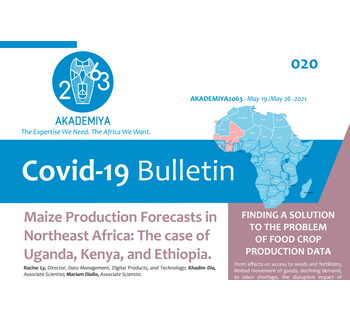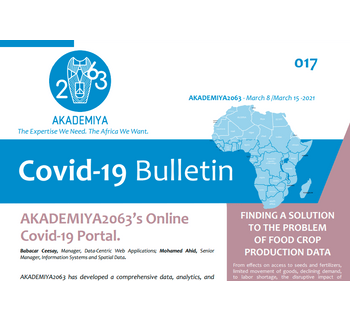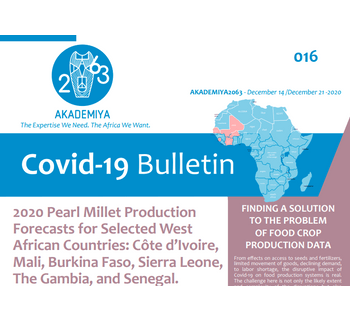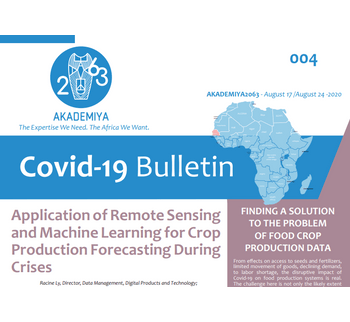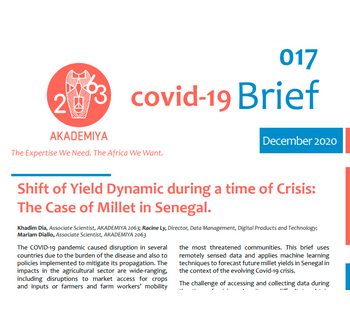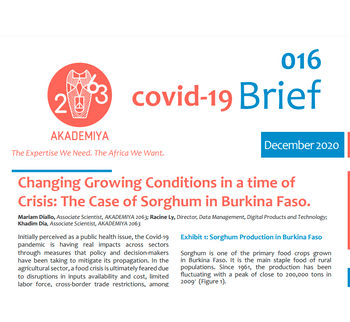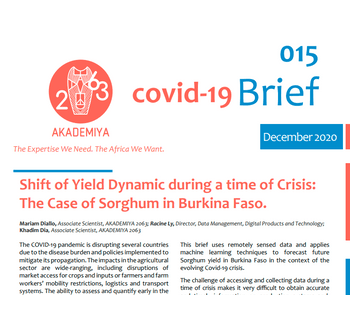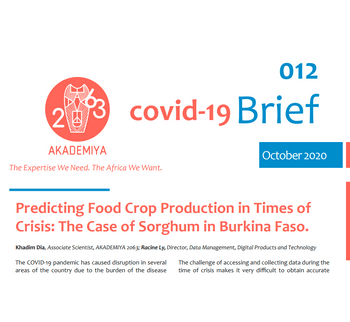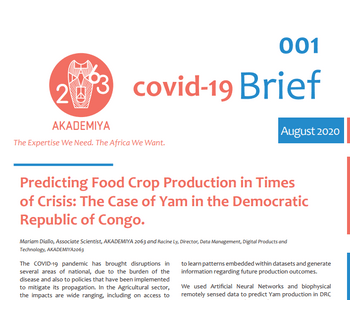AKADEMIYA2063’s COVID-19 portal
Production Systems Disruption
FINDING A SOLUTION TO THE PROBLEM OF FOOD CROP PRODUCTION DATA
From effects on access to seeds and fertilizers, limited movement of goods, declining demand, to labor shortage, the disruptive impact of Covid-19 on food production systems is real. The challenge here is not only the likely extent and complexity of the disruptions but also the difficulty to identify and track them in real time. Unlike the propagation of the disease itself which can be tracked through testing and tracing, it is impossible, even in normal times, to have accurate information on cropping activities. The introduction of confinement and other measures to control the pandemic make the situation even more difficult. There is no way of knowing whether farmers have access to inputs, in time or in adequate quantities, whether they have been too sick to tend to their farmers or could work only partially. One would eventually find out at the end of the growing season from the impact of harvested quantities. One is then left to play catch up to deal with a crisis situation.
The complete lack of information about growing conditions can be overcome by using today’s digital technologies. Remotely sensed data allow to track in real time changes in vegetation cover, weather data and other parameters related to cropping activities. Recent developments in machine learning and computer modeling make it possible to track and predict crop production using these data. The benefits go far beyond the ability to overcome the obstacles to data gathering during crises. The many weaknesses hampering the access to good quality agricultural statistics also can be overcome using the same digital technologies, from measuring arable land, planted areas, crop yields to the spatial distribution of harvested quantities.
Our scientists are using these technologies to assess changes in food production systems during the pandemic and thereby provide valuable information to tackle the impact of the pandemic among local communities.
INTRODUCTION
COVID-19 is expected to have wide ranging impacts on production systems, resulting from a host of disruptions not just to health, but also transport, market and broader food systems. The difficulty of in-person data collection poses a real challenge to assessing the situation and providing an accurate picture of the crisis’ ramifications. Under this workstream, we will use innovative remote sensing, big data and computer learning methodologies to build tools that allow us to evaluate the impact on production systems at the local community level. We will track the growing season for key local staples and apply our tools to issue real time predictions of future food production at community level in a number of countries. Comparisons between predicted 2020 production levels and those of previous years as well as crop modeling techniques will be used to estimate the role of COVID-19 in production disruptions.
Bulletins
Briefs
Data, charts and maps
_and_2017_(MAPSPAM)_ratio_of_Yam_production_in_The_Democratic_Republic_of_Congo_thumb.png)
2020 (predicted) and 2017 (MAPSPAM) ratio of Yam production in The Democratic Republic of Congo
_and_2017_(MAPSPAM)_ratio_of_Yam_production_in_The_Democratic_Republic_of_Congo.png)
Ratio below unity means production reduction in 2020 compared to 2017 and, 2020 yam production increase otherwise. Map source: Mariam Diallo. 2020. Predicting Food Crop Production in Times of Crisis: The Case of Yam in the Democratic Republic of Congo. Covid-19 Brief No. 1, August. Kigali. AKADEMIYA2063.
Download image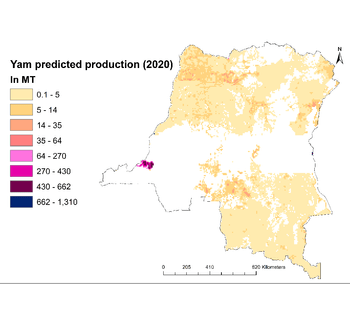
National yam production for The Democratic Republic of Congo forecasted with our model for the current 2020 season

Production unit is in metric tons, and pixels are of size 10km x 10km. Map source: Mariam Diallo. 2020. Predicting Food Crop Production in Times of Crisis: The Case of Yam in the Democratic Republic of Congo. Covid-19 Brief No. 1, August. Kigali. AKADEMIYA2063.
Download image
2017 Spatially Disaggregated yam production in The Democratic Republic of Congo

Production unit is in metric tons, and pixels are of size 10km x 10km. Data source: MapSPAM 2017; Map source: Mariam Diallo. 2020. Predicting Food Crop Production in Times of Crisis: The Case of Yam in the Democratic Republic of Congo. Covid-19 Brief No. 1, August. Kigali. AKADEMIYA2063.
Download image
National millet production in Senegal forecasted with our model for the current 2020 season
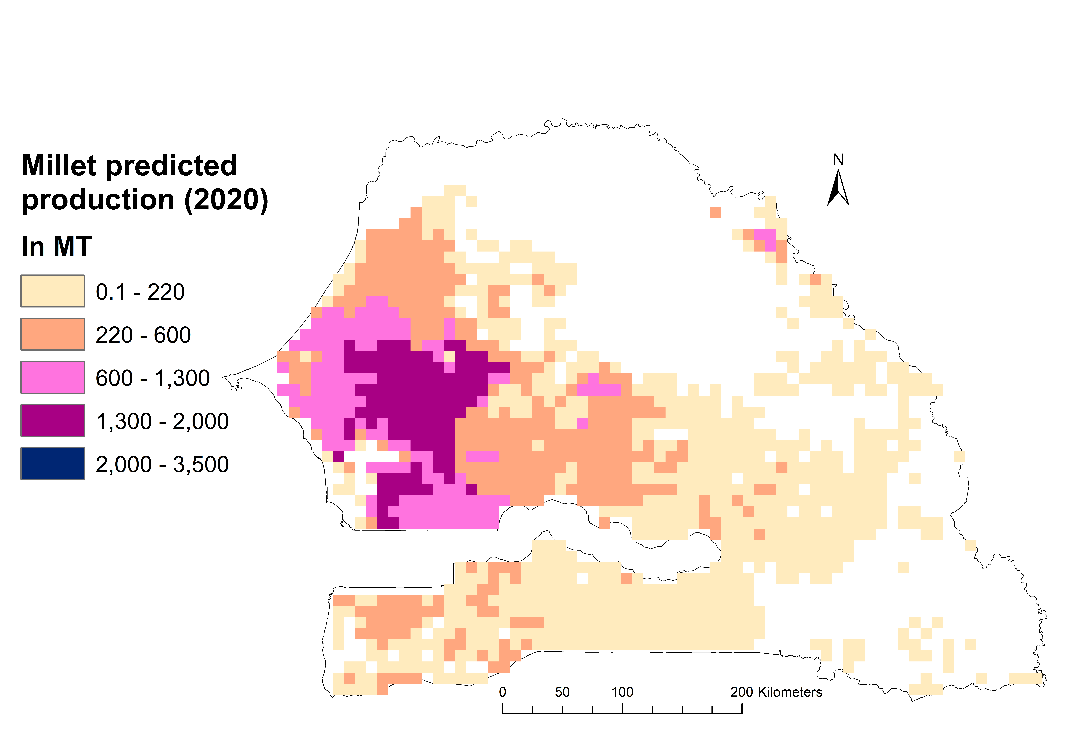
Production unit is in metric tons, and pixels are of size 10km x 10km. Data and map source: Racine Ly, Khadim Dia. 2020. Application of Remote Sensing and Machine Learning for Crop Production Forecasting During Crises. Covid-19 Bulletin No. 4, August. Kigali. AKADEMIYA2063.
Download image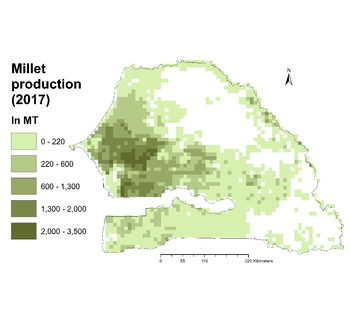
2017 millet production in Senegal

Production unit is in metric tons, and pixels are of size 10km x 10km. Data source: MapSpam 2017. Map source: Racine Ly, Khadim Dia. 2020. Application of Remote Sensing and Machine Learning for Crop Production Forecasting During Crises. Covid-19 Bulletin No. 4, August. Kigali. AKADEMIYA2063.
Download image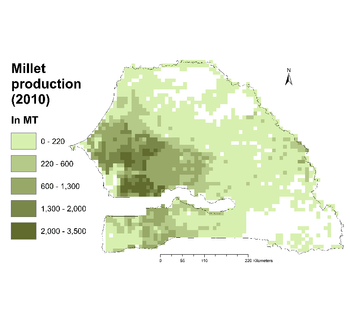
2010 millet production in Senegal

Production unit is in metric tons, and pixels are of size 10km x 10km. Data source: MapSpam 2010. Map source: Racine Ly, Khadim Dia. 2020. Application of Remote Sensing and Machine Learning for Crop Production Forecasting During Crises. Covid-19 Bulletin No. 4, August. Kigali. AKADEMIYA2063.
Download image
2005 production quantities for millet in Senegal

Production units are in metric tons, and pixels are of size 10km x 10km. Data source: MapSpam 2005. Map source: Racine Ly, Khadim Dia. 2020. Application of Remote Sensing and Machine Learning for Crop Production Forecasting During Crises. Covid-19 Bulletin No. 4, August. Kigali. AKADEMIYA2063.
Download image
2010 harvested areas for Millet in Senegal

Pixels are of size 10km x 10km. Data source: MapSpam 2010. Map source: Racine Ly, Khadim Dia. 2020. Application of Remote Sensing and Machine Learning for Crop Production Forecasting During Crises. Covid-19 Bulletin No. 4, August. Kigali. AKADEMIYA2063.
Download image
2017 harvested areas for Millet in Senegal

Pixels are of size 10km x 10km. Data source: MapSpam 2017. Map source: Racine Ly, Khadim Dia. 2020. Application of Remote Sensing and Machine Learning for Crop Production Forecasting During Crises. Covid-19 Bulletin No. 4, August. Kigali. AKADEMIYA2063.
Download image
2005 harvested areas for Millet in Senegal
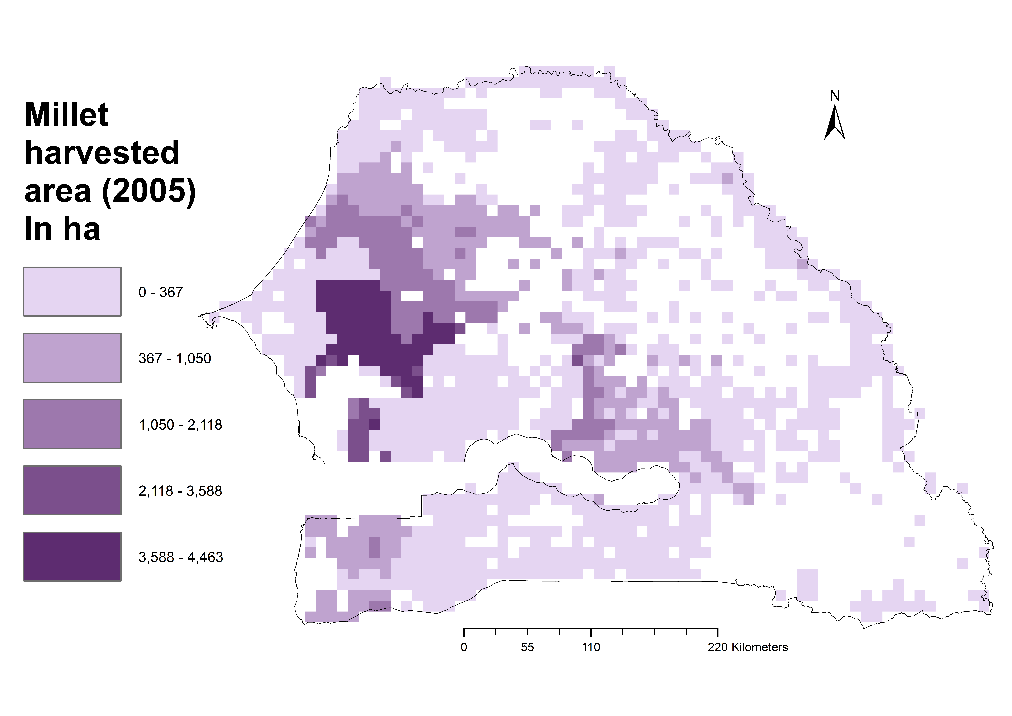
Pixels are of size 10km x 10km. Data source: MapSpam 2005. Map source: Racine Ly, Khadim Dia. 2020. Application of Remote Sensing and Machine Learning for Crop Production Forecasting During Crises. Covid-19 Bulletin No. 4, August. Kigali. AKADEMIYA2063.
Download image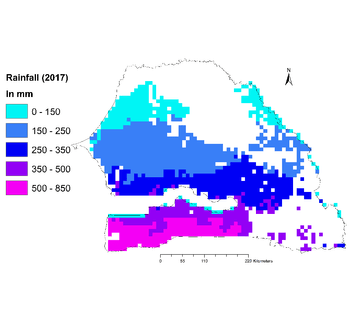
Mean rainfall records during the 2017 millet growing season in Senegal
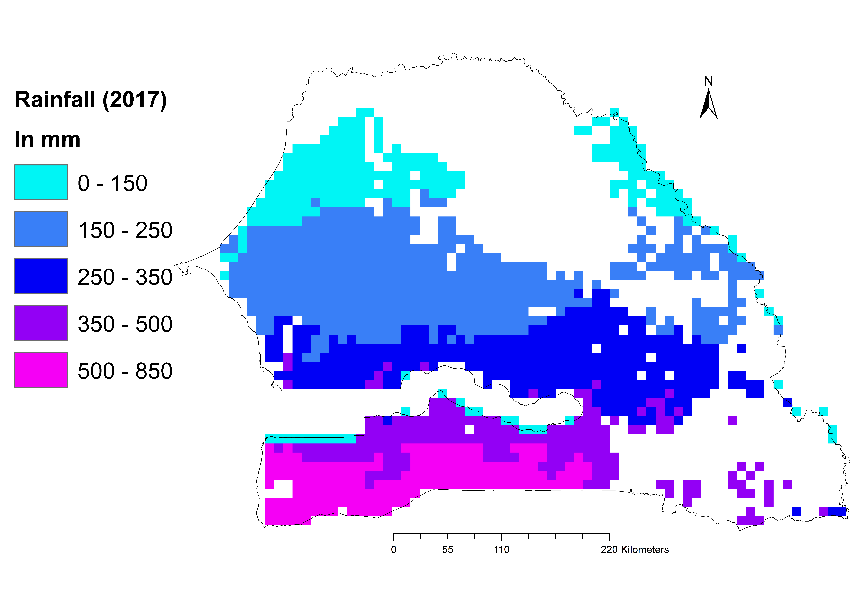
Pixels are of size 10km x 10km and a millet crop mask has been applied to target areas of interest. Data source: CHIRPS. Map source: Racine Ly, Khadim Dia. 2020. Application of Remote Sensing and Machine Learning for Crop Production Forecasting During Crises. Covid-19 Bulletin No. 4, August. Kigali. AKADEMIYA2063.
Download image_during_2017_millet_growing_season_in_Senegal_thumb.png)
Mean Land Surface Temperature (LST) during 2017 millet growing season in Senegal
_during_2017_millet_growing_season_in_Senegal.png)
Pixels are of size 10km x 10km and a millet crop mask has been applied to target areas of interest. Data source: Retrieved from MODIS daytime LST product. Map source: Racine Ly, Khadim Dia. 2020. Application of Remote Sensing and Machine Learning for Crop Production Forecasting During Crises. Covid-19 Bulletin No. 4, August. Kigali. AKADEMIYA2063
Download image_during_the_2017_millet_growing_season_in_Senegal_thumb.png)
Mean Normalized Difference Vegetation Index (NDVI) during the 2017 millet growing season in Senegal
_during_the_2017_millet_growing_season_in_Senegal.png)
Pixels are of size 10km x 10 km and a millet crop mask has been applied to target areas of interest. Data source: Retrieved from MODIS NDVI product. Map source: Racine Ly, Khadim Dia. 2020. Application of Remote Sensing and Machine Learning for Crop Production Forecasting During Crises. Covid-19 Bulletin No. 4, August. Kigali. AKADEMIYA2063.
Download image
Predicted and Observed mean NDVI values on a test dataset for Senegal - Millet
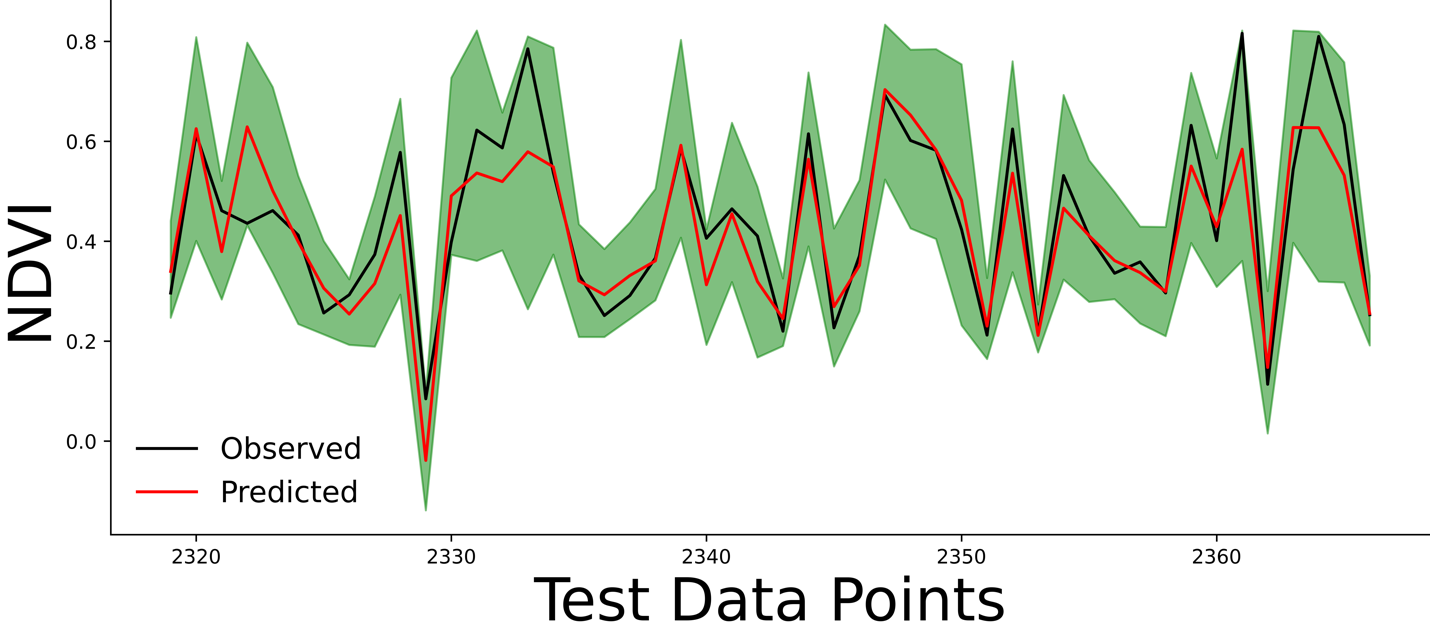
Regression has been performed using a Random Forest model and green area corresponds to empirical 95% confidence interval zone. Source: Racine Ly, Khadim Dia. 2020. Application of Remote Sensing and Machine Learning for Crop Production Forecasting During Crises. Covid-19 Bulletin No. 4, August. Kigali. AKADEMIYA2063.
Download image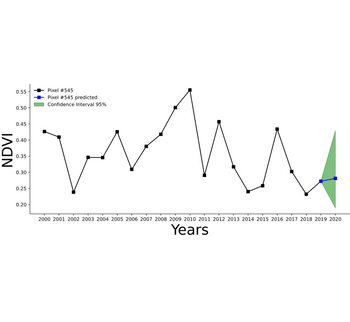
Historical and predicted mean NDVI values for Senegal - Millet

Green area corresponds to empirical 95% confidence interval zone. Graph source: Racine Ly, Khadim Dia. 2020. Application of Remote Sensing and Machine Learning for Crop Production Forecasting During Crises. Covid-19 Bulletin No. 4, August. Kigali. AKADEMIYA2063.
Download imagePast webinars
Other workstreams

Tracking food staples price changes and their impact on food and nutrition security
